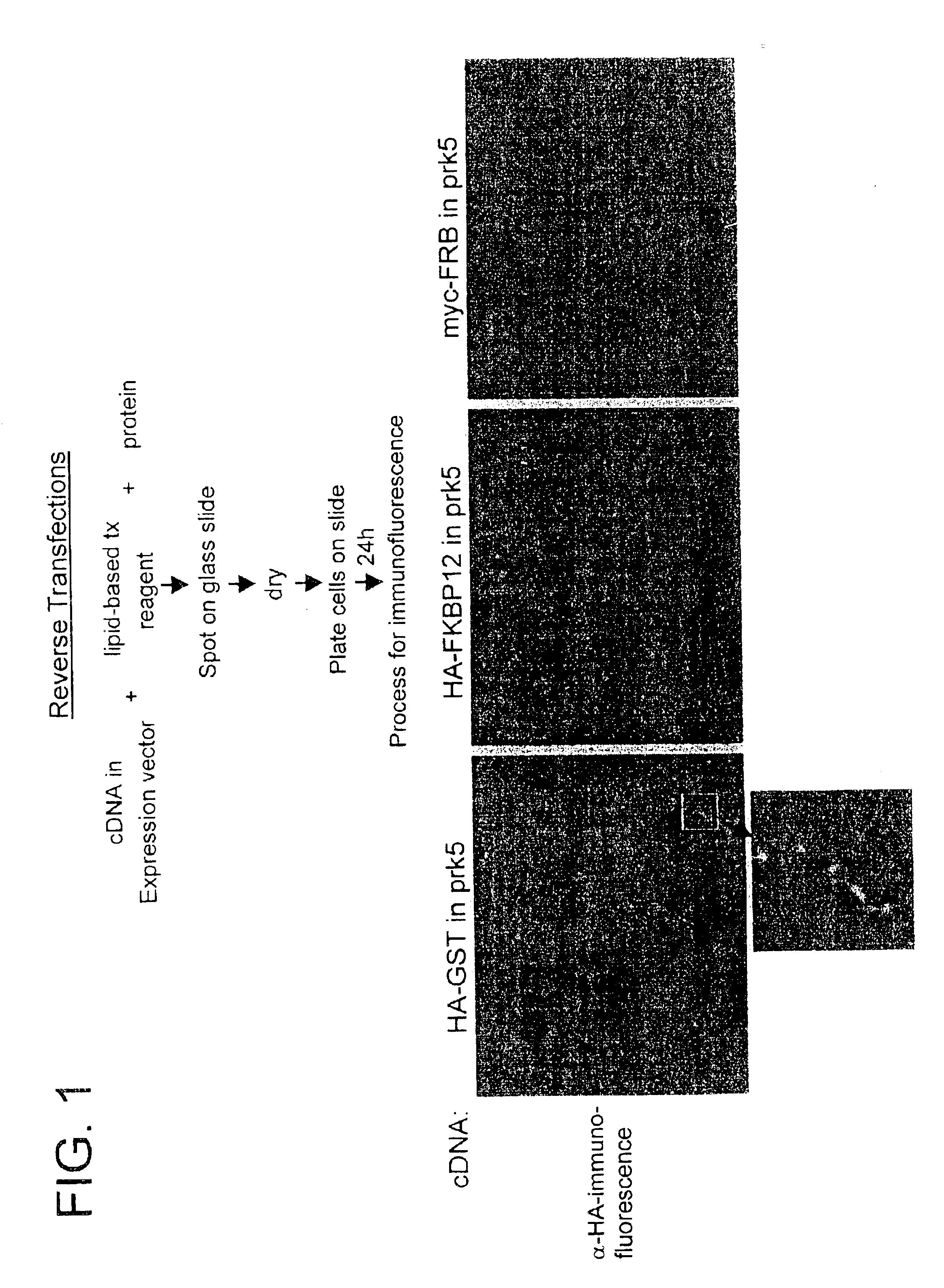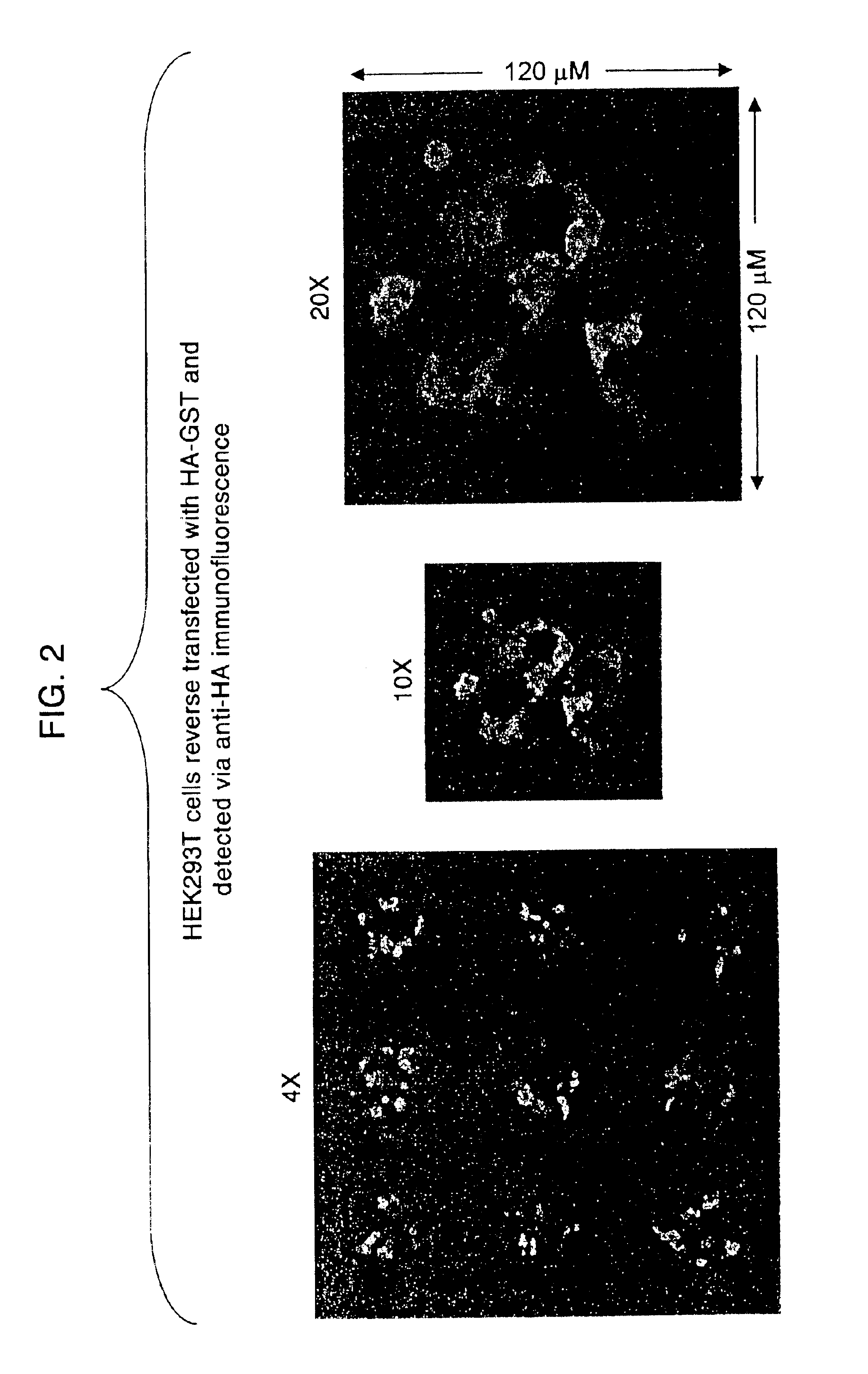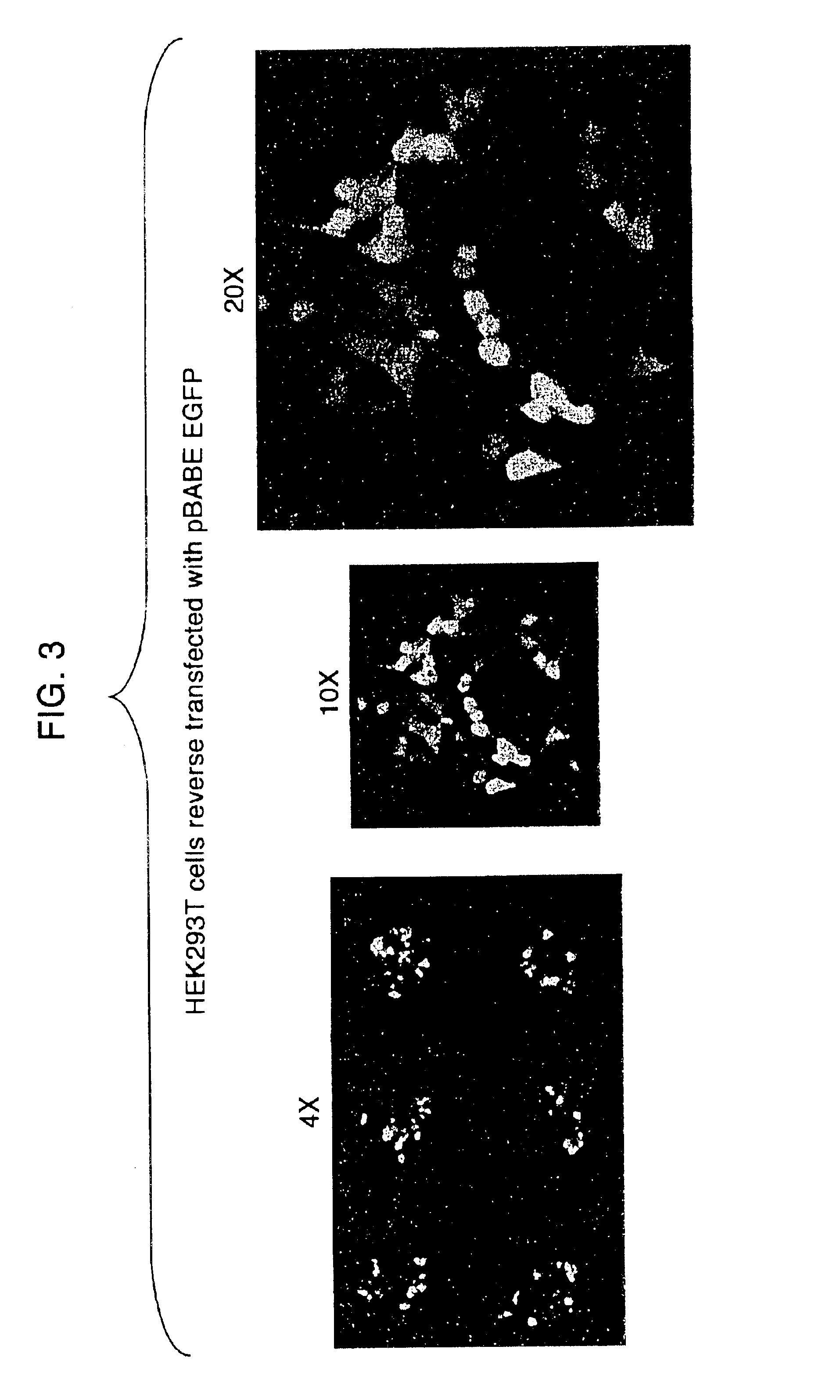Transfection method and uses related thereto
- Summary
- Abstract
- Description
- Claims
- Application Information
AI Technical Summary
Benefits of technology
Problems solved by technology
Method used
Image
Examples
example 1
Reverse Transfection: “Gelatin-DNA” Method
Materials
[0186][DNA]: 1 μg / μL (e.g., HA-GST pRK5, pBABE CMV GFP)[0187]Gelatin (ICN, cat. #901771): 0.2% stock in ddH2O, all dilutions made in PBS-0.20% gelatin=0.5 g gelatin+250 mL ddH2O[0188]EFFECTENE™ Transfection Kit (Qiagen, cat. #301425)[0189]Plasmid-DNA: grown in 100 mL L-amp overnight from glycerol stock, purified by standard QIAPREP Miniprep or Qiagen Plasmid Purification Maxi protocols[0190]Cell Type: HEK 293T cultured in DMEM / 10%IFS with L-glut and pen / strep
Diluting and Spotting DNA[0191]Dilute DNA in 0.2% gelatin* to give final [DNA]=0.05 μg / μL**
[0192]* range of gelatin concentration that worked under the conditions used=0.05% to 0.5%
[0193]** range of DNA concentrations that worked under the conditions used0.01 μg / μl to 0.10 μg / μl [0194]Spot DNA / gelatin mix on Σ poly-L-lysine slides using arrayer[0195]Allow slides to dry in vacuum-dessicator overnight***
[0196]*** range of drying time=2 hours to 1 week
Adding Tx. Reagents to Gelat...
example 2
Reverse Transfection: “Lipid-DNA” Method
Materials
[0209][DNA]: 1 μg / μL (e.g., HA-GST pRK5, pBABE CMV GFP)[0210]Gelatin (ICN, cat.#901771): 0.2% stock in ddH2O, all dilutions made in PBS− 0.05% gelatin=250 μL 0.2%+750 μL PBS−[0211]EFFECTENE™ Transfection Kit (Qiagen, cat.#301425):[0212]EC Buffer in 0.4M sucrose=273.6 μL 50% sucrose+726.4 μL EC Buffer[0213]Plasmid-DNA: grown in 100 mL L-amp overnight from glycerol stock, purified by standard QIAPREP™ Miniprep or Qiagen Plasmid Purification Maxi protocols[0214]Cell Type: HEK 293T cultured in DMEM / 10%IFS with L-glut and pen / strep
Reverse Transfection Protocol with Reduced Volume[0215]Aliquot 1.6 μg DNA in separate eppendorf tubes[0216]Add 15 μL of pre-made DNA-condensation buffer (EC Buffer) with 0.4M sucrose* to tubes
[0217]* range of sucrose that worked under the conditions used=0.1M to 0.4M [0218]Add 1.6 μL of Enhancer solution and mix by pipetting several times. Incubate at room temperature for 5 minutes[0219]Add 5 μL of EFFECTENE™ Tra...
example 3
Transfected Cells Microarrays: A Genomics Approach for the Analysis of Gene Products in Mammalian Cells
Lipid-DNA Method
I. Gelatin Preparation and DNA Purification
Materials:
[0229]Gamma-Amino Propyl Silane (GAPS) slides (Corning catalog #2550),[0230]Purified cDNA,[0231]Gelatin, Type B: 225 Bloom (Sigma, catalog #G-9391),
Methods
[0232]0.2% Gelatin was made by incubation in a 60° C. water bath for 15 minutes. The gelatin was cooled slowly to 37° C. at which point it was filtered through 0.45 μm cellular acetate membrane (CA).
[0233]Bacterial clones with DNA plasmids were grown in a 96 Deep-Well Dish for 18 to 24 hours in 1.3 mL of terrific broth (TB) shaking at 250 rpm at 37° C. The plasmids were miniprepped and optical density (OD) was taken. DNA purity, as indicated by final 280 nm / 260 nm absorbance ratio, was greater than 1.7.
Storage
[0234]For storage purposes, gelatin was kept at 4° C. and miniprepped DNA kept at −20° C.
II. Sample Preparation and Array Printing
Materials
[0235]EFFECTENE™...
PUM
| Property | Measurement | Unit |
|---|---|---|
| concentration | aaaaa | aaaaa |
| concentration | aaaaa | aaaaa |
| concentration | aaaaa | aaaaa |
Abstract
Description
Claims
Application Information
 Login to View More
Login to View More - R&D
- Intellectual Property
- Life Sciences
- Materials
- Tech Scout
- Unparalleled Data Quality
- Higher Quality Content
- 60% Fewer Hallucinations
Browse by: Latest US Patents, China's latest patents, Technical Efficacy Thesaurus, Application Domain, Technology Topic, Popular Technical Reports.
© 2025 PatSnap. All rights reserved.Legal|Privacy policy|Modern Slavery Act Transparency Statement|Sitemap|About US| Contact US: help@patsnap.com



